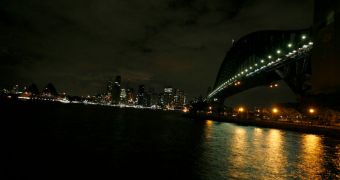With 134 countries showing their commitment to the cause it stands for, Earth Hour 2011 has become the largest and most successful iteration of the event since 2007,when it all began. The global community managed to demonstrate that it can still show cohesion when faced with a common threat.
Earth Hour, as a movement, is a call for action on the environment, that has become tremendously popular around the world since first being held in Sydney, Australia, some four years ago.
Since then, increasing numbers of people and countries have adopted it. The movement calls for all lights to be shut-down for an entire hour in late March. This year's event took place on Saturday, March 26, between 20:30 and 21:30 local time.
The manifestation began in Japan and surrounding areas, and then spread across Asia, Australia and New Zealand, Africa, Europe and both Americas. Visually, the effect was astounding throughout.
Unlike past years, 2011 saw organizers asking participants for a so-called commitment Beyond the Hour. This was symbolized by asking them to extend the actions they took during the actual event to other days of the year as well.
“The Beyond the Hour call to action has been unanimously answered by people worldwide. From school children in Singapore, to Heads of State from the UK, to Australia, Pakistan and Colombia, people have shown that Earth Hour has evolved beyond lights-out,” says Andy Ridley.
“This year’s event has illustrated without question what can be achieved when people unite with a common purpose and rally to action,” adds Ridley, the co-founder and executive director of Earth Hour.
Brazil was among the most dedicated participants, with nearly 124 cities announcing that they will observe Earth Hour 2011. That is the equivalent of 66 percent of their state capitals. All five major regions in the country were involved.
The illumination on Christ the Redeemer statue, in Rio de Janeiro, was shut down for the event, as were lights usually placed on the 96 buildings in the UN complex housed in New York City.
Broadway theaters, the Empire State Building and some Times Square buildings also shut down their lights during Earth Hour 2011. The Las Vegas strip was also darkened during the event.
“Through the simple gesture of turning off the lights, Earth Hour has captured the world’s imagination, growing significantly year after year and 2011 is no exception,” WWF US chief marketing officer Terry Macko.
“Our goal this year was for even more people to engage in Earth Hour, and the response has been simply amazing,” the official went on to say. The WWF played a pivotal role in founding Earth Hour.
“We appreciate the individuals, communities, governments and organizations that are stepping up to the plate and 'owning' Earth Hour and helping spread the critical message of sustainable living across the world,” Macko concludes.

 14 DAY TRIAL //
14 DAY TRIAL //